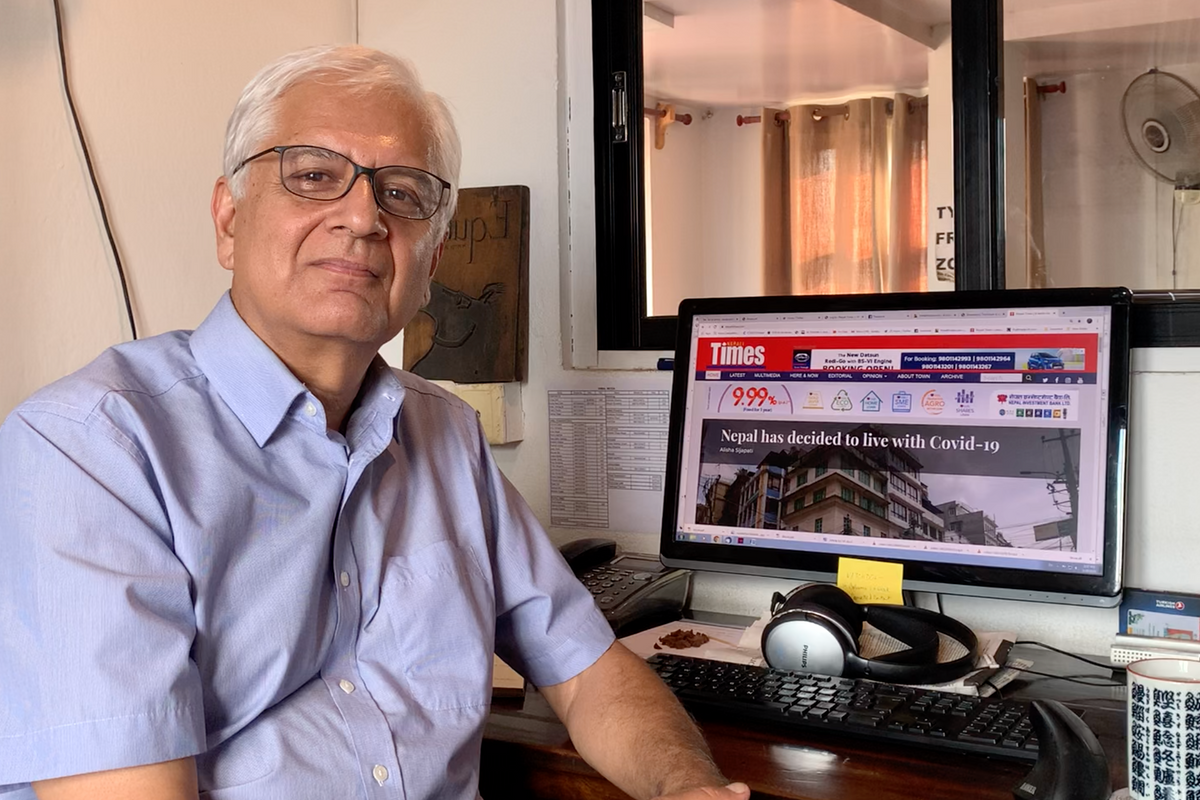
Writing journeys
8 MIN READ

In this edition of Writing Journeys, Tom Robertson interviews Kunda Dixit, editor of Nepali Times, about his writing regimen.

Writing can be wrenchingly difficult, but also fun. In this weekly series, I ask well-known Nepali authors and storytellers such as Shradha Ghale, Sarita Pariyar, Kesang Tseten, and Deepak Gyawali to reflect on how they learned to write, who taught them, and what practical tips and suggestions they have for fellow Nepali non-fiction writers.
I ask them to tell us about favorite authors, favorite forms of punctuation, and favorite times of the day to write. I ask about researching, interviewing, writing, and publishing. Some authors responded with short essays, others preferred a question-and-answer style.
I found their answers interesting, inspiring, reassuring, and useful. I hope you do, too.
This week Kunda Dixit shares some reflections on clear writing, a topic near and dear to my heart. Kunda is the longtime editor of the English weekly Nepali Times. His books include the media textbook, Dateline Earth: Journalism As If the Planet Mattered (1997), and ‘A People War’, a trilogy of photo books on the Nepal conflict. He has mentored scores of Nepali journalists and authors. Thanks to Kunda and our other authors for sharing.
Coming next week: Niranjan Kunwar
How did you learn to write?
I was probably born with ink in my blood, since all my known ancestors were writers, historians, or poets. My two siblings and I started a hand-written family newspaper, and I was a सम्पादक when I was 10!
What tips or realizations or activities helped you improve?
The most important tip from my teachers was that we should write simply and clearly. Writing is not about showing off your vocabulary or craft, but about communicating clearly and well.
What writing suggestions do you have for writers?
The more complicated the subject you are writing about, the simpler your language should be. That does not mean keeping it dry and monotonous, the sentences should show passion for, and engagement with, the subject matter.
Who taught you to write and how? Can you tell us about a favorite teacher or mentor who helped your writing?
In high school at St. Xavier's in Godavari, at the southern edge of the Kathmandu Valley, our excellent teachers made us practice writing correctly, and with flair. Eugene Watrin inspired us to write skillfully, James Donnelly made sure we had our conjunctions, prepositions, and punctuations right. Khanal Sir showed us that सरल नेपाली is राम्रो नेपाली.
That training and practice in Godavari at age 11-12 has lasted a lifetime, and for me, many of these rules now apply equally to Nepali writing.
Besides excellent content, what makes a well-written article?
After language, it is the structure that is most important. Any piece of journalistic writing has to follow a logical, linear flow, and the trick is to keep things moving, maintain a sense of anticipation. And the tone has to correspond to the content.
What are ways to keep things moving? Can you point us to writers about Nepal who do this well?
Every story — from bed-time fairy tales to investigative journalism pieces — has a counterpoint, a tension, even conflict to the plot. The trick is not to tell everything at the start, build up the drama step by step, so that readers are persuaded to keep on reading. Sudeep Shrestha of Setopati and Sarat Chandra Wasti in Kantipur do a good job in keeping this narrative tension in their historical pieces about Kathmandu Valley and columns.
How does journalistic writing differ from general or academic writing?
Different audiences. There are strict rules for writing research papers, where the language is by definition very technical, there have to be citations, references, footnotes. Academic writing does not travel well, and most lay readers will tune off. Journalism is the go-between – we try to explain technical, scientific concepts to a general readership without sacrificing too much nuance, detail, and accuracy.
Are there tricks for explaining technical, scientific concepts to a general readership? What writers do this particularly well?
The master craftsmen in this are the writers and editors at The Economist. A subscription to this magazine is well worth it. Skip the detailed financial reporting part, but the sections on science and technology, the environment, developing countries, and even the obituaries are very well written. They manage to demystify the most complicated scientific, economic or political stories in easy-to-digest prose.
From the perspective of writing technique, who are your favorite Nepali writers, books, or magazines? Why? Favorite non-Nepali writers?
भैरव अर्याल, पारिजात, इन्द्रबहादुर राइ, ‘बसाईँ’, ‘अन्तरमनको यात्रा’, जिवन काँडाकि फुल’ – colloquial, de-Sanskritised Nepali at its simplest and most effective.
Milan Kundera, Michael Ondaatje, The Anarchy by William Dalrymple, Underland: A Deep Time Journey by Robert Macfarlane.
What are the secrets to an effective op-ed?
An op-ed is opinion writing, and like all opinion, it has to be persuasive. The idea is not to hit someone over the head with an ax but to carefully dismantle the other side’s argument with a scalpel. After all, we are not trying to preach to the converted but to bring around those who do not necessarily agree with us.
How do you learn quickly about a new topic?
Google? Haha. Just half-joking. Site search specialist journals, bring yourself up to speed before talking to experts to get the inside story, a fresh perspective, or a new angle. And based on new evidence, be prepared to change your long-held beliefs. Don’t be too rigid in your conventional convictions.
Could you give an example or explain a little?
Most of us are radical or left of center when young, we are so outraged by injustices that we easily buy into ideological rhetoric and slogans. Sometimes this strait-jackets our own beliefs so that we do not listen to other lines of thought. These days populist dogmas are like that. Being too much of a contrarian is also tiresome to others, but to be able to question our own long-held beliefs is an essential element of independent thought. It hampers the creative process when the cause becomes more important than the art. Social reform is the end goal, but don't wear it on your sleeves because you will end up sounding too preachy and prescriptive.
What strategies are helpful when interviewing someone? What mistakes do many interviewers make?
Don’t call cold. Text first, be clear and precise about what you want, whether the interview is on-record or not, if it is a profile, feature, or a Q&A. Use ice-breakers, keep the toughest questions for last. Eye contact. Show respect.
What advice do you have for academics who want to write for a general audience?
That is a tough one. Some academics are very strict and do not want even a comma changed. Others understand that the editor’s job is to translate a turgid research paper into journalese so that it gets to a larger public. It is a trade-off – balancing academic rigor with reach. Some scientists are great communicators, we should learn from them. The best example of simple, specialist writing in English is to be found in The Economist.
What helps you be productive?
In journalism, speed matters, so being productive is even more important than in other writing jobs. Editors also need to churn out content, and the trick is to make sure that quality does not suffer when we have to reach a word count target.
Do you find any software or apps particularly helpful?
Don’t really use them. I grew up writing on typewriters – we were the last batch at Columbia Journalism School still using typewriters in 1985. So, I find grammar correction software and autocorrect features irritating because they sometimes make much more embarrassing mistakes while correcting my small typo.

Do you and your brother Kanak have different ideas or habits related to writing?
His is closer to academic writing, and he tends to prefer long-form. I think my BBC radio script job and 14 years with a wire service turned me into someone incapable of exceeding 1,000 words per piece.
Anything else you'd like to add? Any stories you'd like to share?
The most fulfilling thing I have done in my journalism career is to curate a trilogy of photobooks on the [Maoist] conflict. It proved to me that pictures do indeed say a thousand words, but that it is the text in the caption or the photo story which, when combined, ends up magnifying the impact of both.
As a media school teacher, I also find that some students think writing is not important because they are going into film-making or photography. Writing is important no matter which profession you choose, and your writing improves in direct proportion to the number of books you read.

Tom Robertson Tom Robertson, PhD, is an environmental historian who writes about Kathmandu and Nepali history. His Nepali-language video series on writing, 'Mitho Lekhai', is available on Youtube. His most recent article, 'No smoke without fire in Kathmandu’, appeared on March 5 in Nepali Times.

